2021 HYUNDAI ELANTRA HYBRID display
[x] Cancel search: displayPage 6 of 555
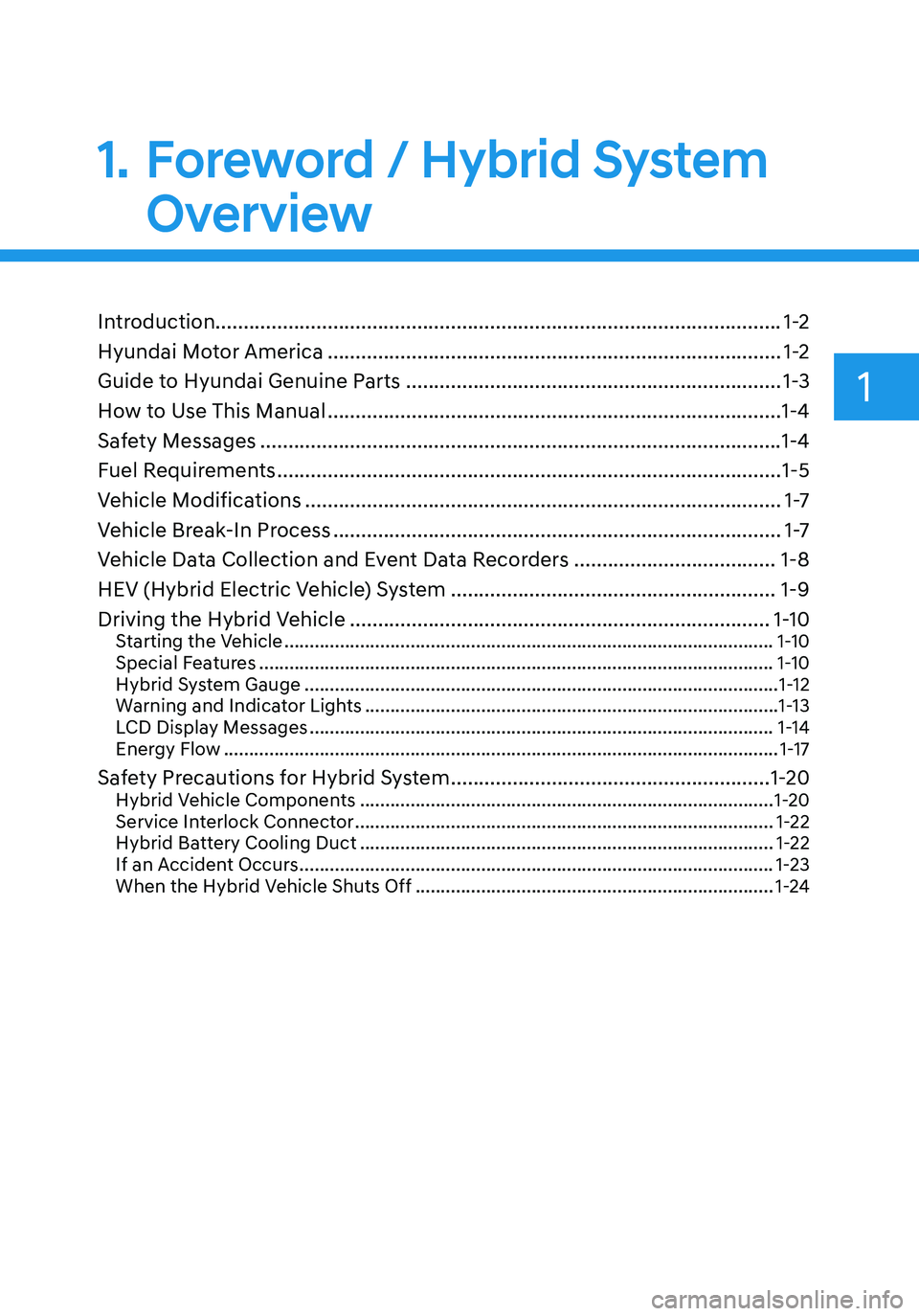
Introduction........................................................................\
............................. 1-2
Hyundai Motor America
........................................................................\
.........1-2
Guide to Hyundai Genuine Parts
...................................................................1-3
How to Use This Manual
........................................................................\
.........1-4
Safety Messages
........................................................................\
.....................1-4
Fuel Requirements
........................................................................\
..................1-5
Vehicle Modifications
........................................................................\
.............1 -7
Vehicle Break-In Process
........................................................................\
........1 -7
Vehicle Data Collection and Event Data Recorders
....................................1-8
HEV (Hybrid Electric Vehicle) System
..........................................................1-9
Driving the Hybrid Vehicle
........................................................................\
...1-10Starting the Vehicle ........................................................................\
.........................1-10
Special Features ........................................................................\
..............................1-10
Hybrid System Gauge ........................................................................\
......................1-12
Warning and Indicator Lights ........................................................................\
..........1-13
LCD Display Messages ........................................................................\
....................1-14
Energy Flow ........................................................................\
......................................1-17
Safety Precautions for Hybrid System .........................................................1-20Hybrid Vehicle Components ........................................................................\
..........1-20
Service Interlock Connector ........................................................................\
...........1-22
Hybrid Battery Cooling Duct ........................................................................\
..........1-22
If an Accident Occurs ........................................................................\
......................1-23
When the Hybrid Vehicle Shuts Off .......................................................................1-24
Foreword / Hybrid System Overview
1. Foreword / Hybrid System
Overview
1
Page 19 of 555

Foreword / Hybrid System Overview
1-14
LCD Display Messages
Ready to start driving
OOSHQ019003L
This message is displayed when the
vehicle is ready to be driven.
Check regenerative brakes
OOSHQ019004L
This message is displayed when
the brake performance is low or the
regenerative brake does not work
properly due to a problem in the brake
system.
If this occurs, it may take longer for the
brake pedal to operate and the braking
distance may become longer.
Stop vehicle and check brakes
OOSHQ019006L
This message is displayed when a
problem occurs in the brake system.
If this occurs, park the vehicle in a
safe location and we recommend that
you tow your vehicle to the nearest
authorized HYUNDAI dealer and have the
vehicle inspected.
Check Hybrid system
OOSHQ019005L
This message is displayed when there is a
problem with the hybrid control system.
Refrain from driving when the warning
message is displayed.
If this occurs, we recommend that
you have the vehicle inspected by an
authorized HYUNDAI dealer.
Page 20 of 555
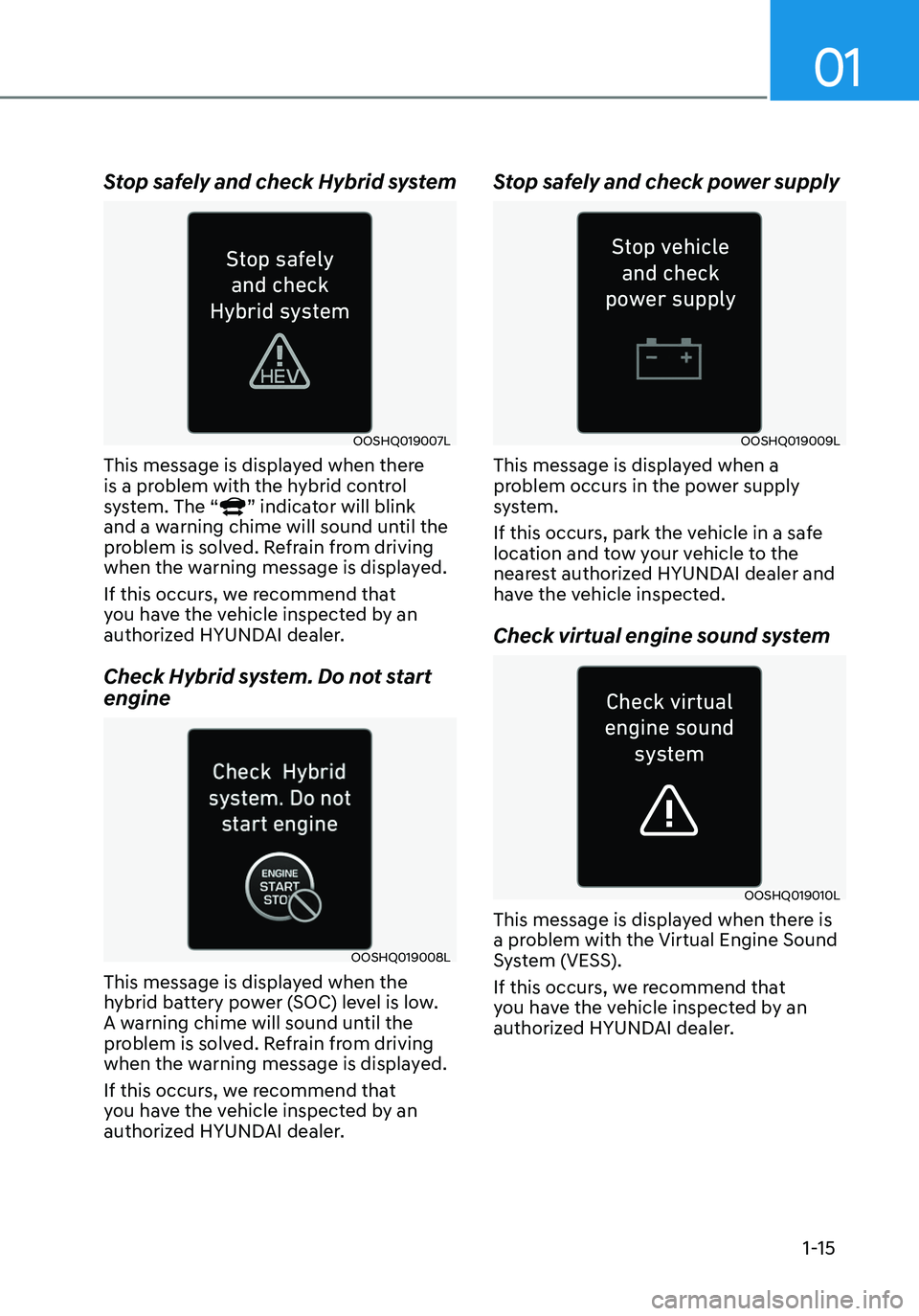
01
1-15
Stop safely and check Hybrid system
OOSHQ019007L
This message is displayed when there
is a problem with the hybrid control
system. The “
” indicator will blink and a warning chime will sound until the
problem is solved. Refrain from driving
when the warning message is displayed.
If this occurs, we recommend that
you have the vehicle inspected by an
authorized HYUNDAI dealer.
Check Hybrid system. Do not start
engine
OOSHQ019008L
This message is displayed when the
hybrid battery power (SOC) level is low.
A warning chime will sound until the
problem is solved. Refrain from driving
when the warning message is displayed.
If this occurs, we recommend that
you have the vehicle inspected by an
authorized HYUNDAI dealer.
Stop safely and check power supply
OOSHQ019009L
This message is displayed when a
problem occurs in the power supply
system.
If this occurs, park the vehicle in a safe
location and tow your vehicle to the
nearest authorized HYUNDAI dealer and
have the vehicle inspected.
Check virtual engine sound system
OOSHQ019010L
This message is displayed when there is
a problem with the Virtual Engine Sound
System (VESS).
If this occurs, we recommend that
you have the vehicle inspected by an
authorized HYUNDAI dealer.
Page 21 of 555
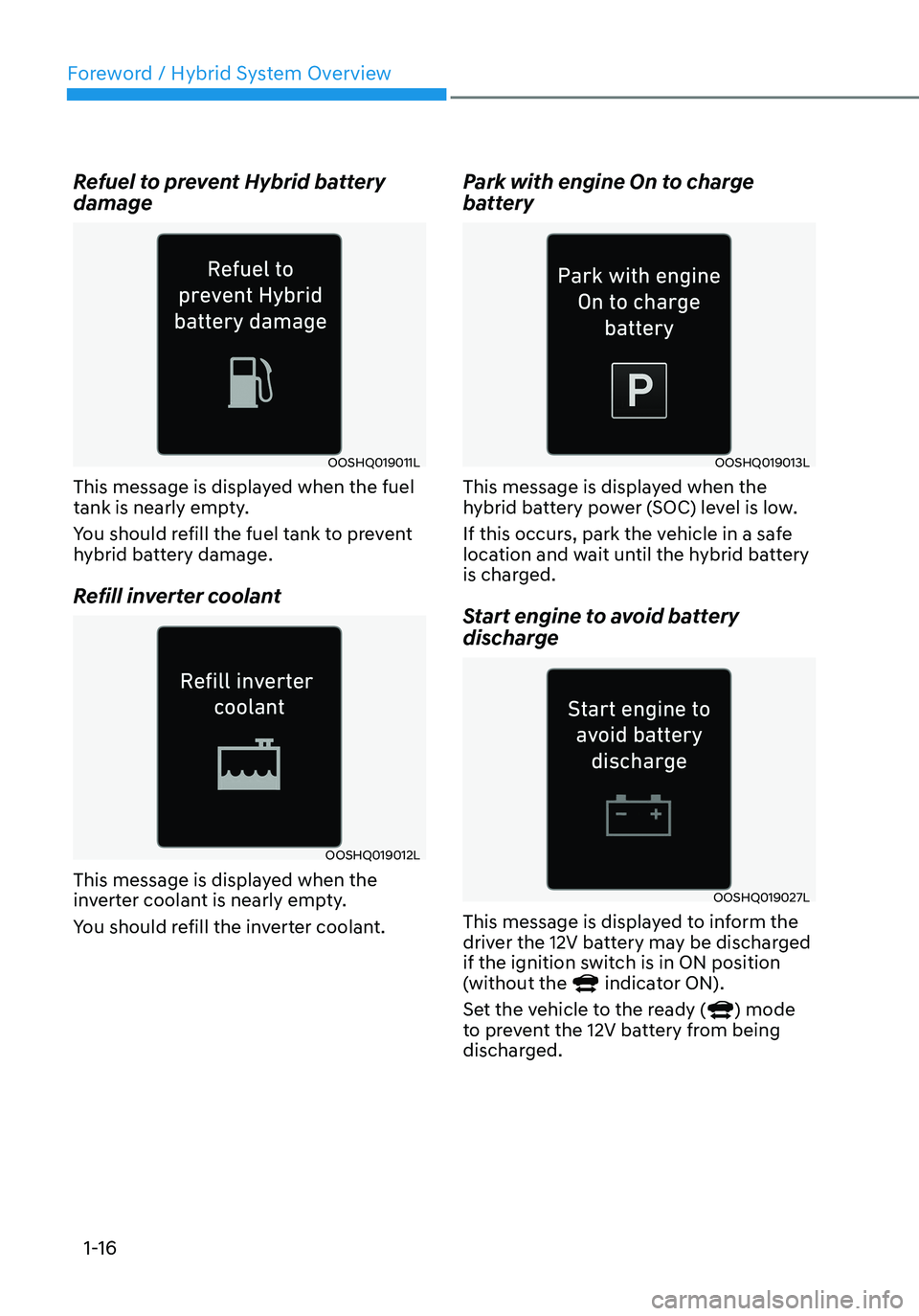
Foreword / Hybrid System Overview
1-16
Refuel to prevent Hybrid battery
damage
OOSHQ019011L
This message is displayed when the fuel
tank is nearly empty.
You should refill the fuel tank to prevent
hybrid battery damage.
Refill inverter coolant
OOSHQ019012L
This message is displayed when the
inverter coolant is nearly empty.
You should refill the inverter coolant.
Park with engine On to charge
battery
OOSHQ019013L
This message is displayed when the
hybrid battery power (SOC) level is low.
If this occurs, park the vehicle in a safe
location and wait until the hybrid battery
is charged.
Start engine to avoid battery
discharge
OOSHQ019027L
This message is displayed to inform the
driver the 12V battery may be discharged
if the ignition switch is in ON position
(without the
indicator ON).
Set the vehicle to the ready () mode to prevent the 12V battery from being
discharged.
Page 22 of 555
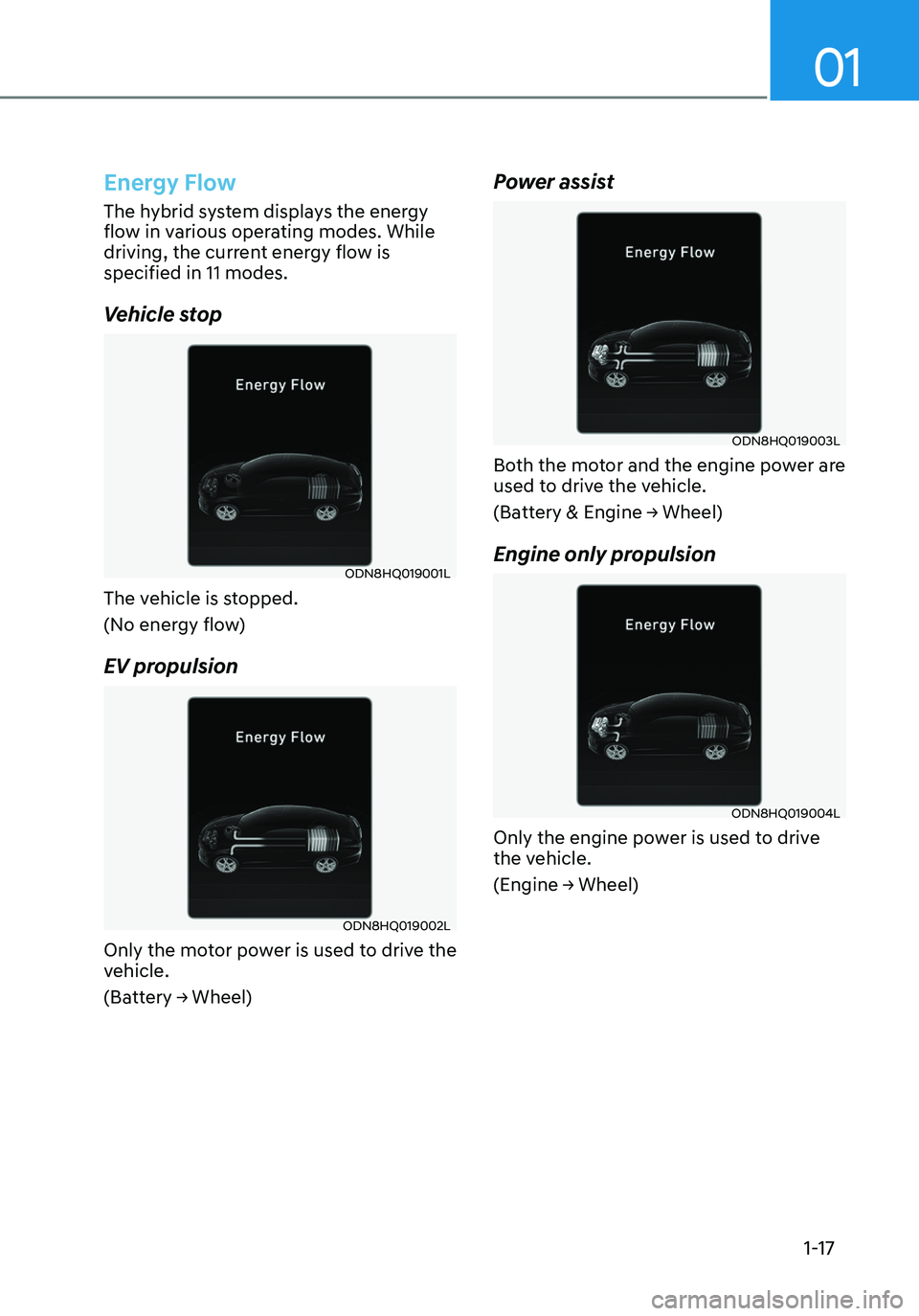
01
1-17
Energy Flow
The hybrid system displays the energy
flow in various operating modes. While
driving, the current energy flow is
specified in 11 modes.
Vehicle stop
ODN8HQ019001L
The vehicle is stopped.
(No energy flow)
EV propulsion
ODN8HQ019002L
Only the motor power is used to drive the
vehicle.
(Battery → Wheel)
Power assist
ODN8HQ019003L
Both the motor and the engine power are
used to drive the vehicle.
(Battery & Engine → Wheel)
Engine only propulsion
ODN8HQ019004L
Only the engine power is used to drive
the vehicle.
(Engine → Wheel)
Page 41 of 555
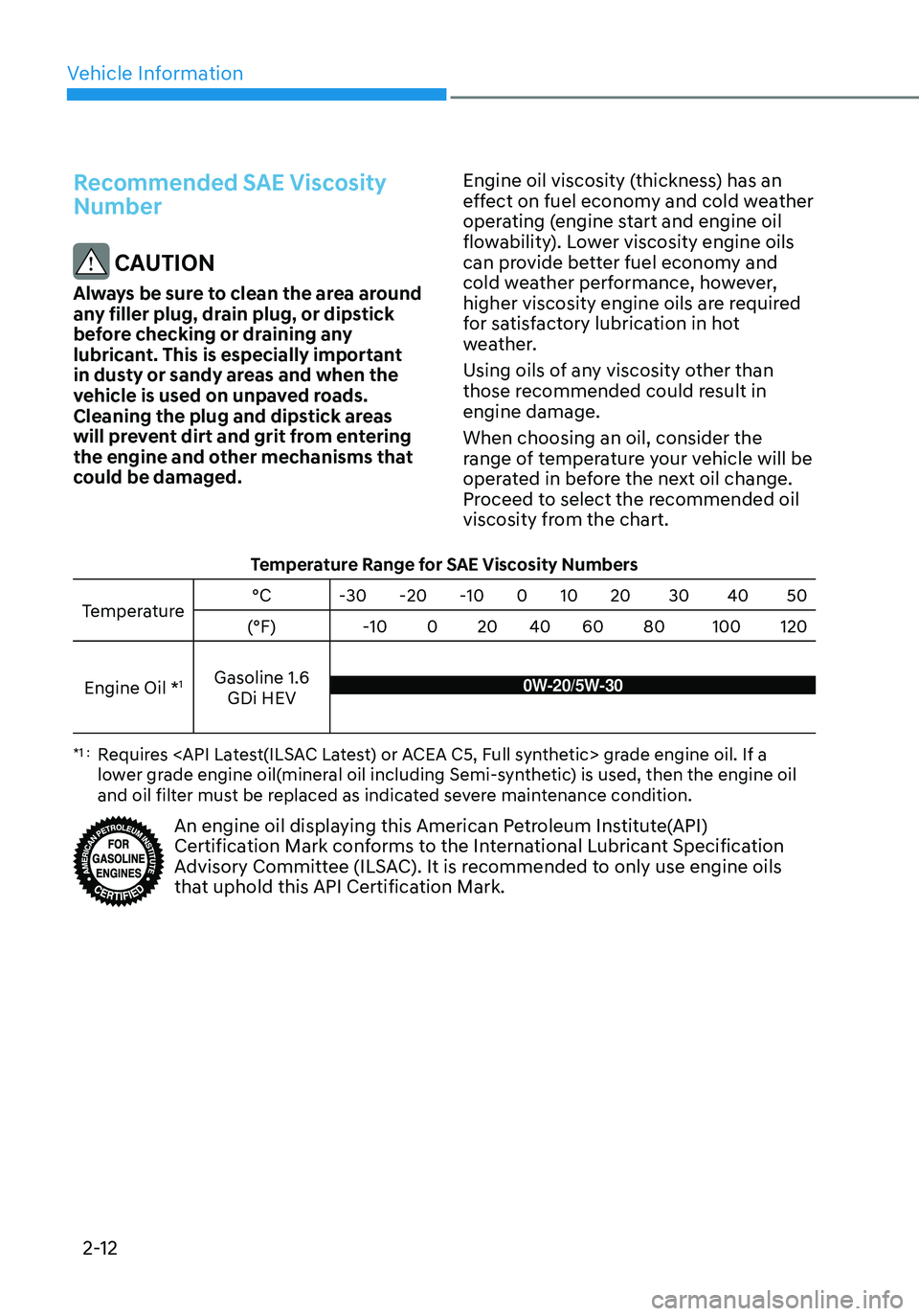
Vehicle Information
2-12
Recommended SAE Viscosity
Number
CAUTION
Always be sure to clean the area around
any filler plug, drain plug, or dipstick
before checking or draining any
lubricant. This is especially important
in dusty or sandy areas and when the
vehicle is used on unpaved roads.
Cleaning the plug and dipstick areas
will prevent dirt and grit from entering
the engine and other mechanisms that
could be damaged.Engine oil viscosity (thickness) has an
effect on fuel economy and cold weather
operating (engine start and engine oil
flowability). Lower viscosity engine oils
can provide better fuel economy and
cold weather performance, however,
higher viscosity engine oils are required
for satisfactory lubrication in hot
weather.
Using oils of any viscosity other than
those recommended could result in
engine damage.
When choosing an oil, consider the
range of temperature your vehicle will be
operated in before the next oil change.
Proceed to select the recommended oil
viscosity from the chart.
Temperature Range for SAE Viscosity Numbers
Temperature °C
-30 -20 -10 0 10 20 30 40 50
(°F) -10 0 20 40 60 80 100 120
Engine Oil *
1Gasoline 1.6 GDi HEV0W-20/5W-30
*1 : Requires
lower grade engine oil(mineral oil including Semi-synthetic) is used, then the engine oil
and oil filter must be replaced as indicated severe maintenance condition.
An engine oil displaying this American Petroleum Institute(API)
Certification Mark conforms to the International Lubricant Specification
Advisory Committee (ILSAC). It is recommended to only use engine oils
that uphold this API Certification Mark.
Page 87 of 555

3-42
SRS warning light
The SRS (Supplement Restraint System)
air bag warning light on the instrument
panel displays the air bag symbol
depicted in the illustration. The system
checks the air bag electrical system for
malfunctions. The light indicates that
there is a potential malfunction with your
air bag system, which could include your
side and curtain air bags used for rollover
protection.
WARNING
If your SRS malfunctions, the air bag
may not inflate properly during an
accident increasing the risk of serious
injury or death.
If any of the following conditions occur,
your SRS is malfunctioning:
• The light does not turn on for
approximately three to six seconds
when the Engine Start/Stop button is
in the ON position.
• The light stays on after illuminating
for approximately three to six
seconds.
• The light comes on while the vehicle
is in motion.
• The light blinks when the engine is
running.
Have an authorized HYUNDAI dealer
inspect the SRS as soon as possible if
any of these conditions occur.
During a frontal collision, sensors will
detect the vehicle’s deceleration. If the
rate of deceleration is high enough, the
control unit will inflate the front air bags.
The front air bags help protect the driver
and front passenger by responding to
frontal impacts in which seat belts alone
cannot provide adequate restraint. When
needed, the side air bags help provide
protection in the event of a side impact
or rollover. •
Air bags are activated (able to inflate
if necessary) when the Engine Start/
Stop button is in the ON position or
approximately within 3 minutes after
ignition off.
• Air bags inflate in the event of certain
frontal or side collisions to help
protect the occupants from serious
physical injury.
• Generally, air bags are designed to
inflate based upon the severity of
a collision, its direction, etc. These
two factors determine whether
the sensors produce an electronic
deployment/inflation signal.
• The front air bags will completely
inflate and deflate in an instant. It is
virtually impossible for you to see the
air bags inflate during an accident. It is
much more likely that you will simply
see the deflated air bags hanging out
of their storage compartments after
the collision.
• In addition to inflating in certain side
collisions, vehicles equipped with a
rollover sensor, side and curtain air
bags will inflate if the sensing system
detects a rollover.
When a rollover is detected, side and
curtain air bags will remain inflated
longer to help provide protection
from ejection, especially when used in
conjunction with the seat belts.
• To help provide protection, the air
bags must inflate rapidly. The speed
of air bag inflation is a consequence
of extremely short time in which
to inflate the air bag between the
occupant and the vehicle structures
before the occupant impacts those
structures. This speed of inflation
reduces the risk of serious or life-
threatening injuries and is thus a
necessary part of air bag design.
However, the rapid air bag inflation
can also cause injuries which can
include facial abrasions, bruises and
broken bones because the inflation
speed also causes the air bags to
expand with a great deal of force.
Seats & Safety System
Page 103 of 555

High Beam Assist indicator light ........................................................................\
..4-18
Forward Collision-Avoidance Assist Warning Light ............................................4-18
Lane Keep Assist Indicator Light ........................................................................\
.. 4-19
Cruise Indicator Light
........................................................................\
...................4-19
SPORT Mode Indicator Light ........................................................................\
........4-19
SMART Mode Indicator Light ........................................................................\
.......4-19
Icy Road Warning Light ........................................................................\
................4-19
LCD Display Messages ........................................................................\
...................4-20
Shift to P or N to start engine (for smart key system) .......................................4-20
Shift to P (for smart key system and intelligent variable transmission) ...........4-20
Low key battery (for smart key system) ..............................................................4-20
Press brake pedal to start engine (for smart key system and intelligent
variable transmission)........................................................................\
.................. 4-20
Press clutch pedal to start engine (for smart key system and manual
transmission)
........................................................................\
................................4-20
Key not in vehicle (for smart key system) ...........................................................4-20
Key not detected (for smart key system) ............................................................4-20
Press START button again (for smart key system)
.............................................4-20
12V battery discharging due to additional electrical devices ...........................4-21
Press START button with key (for smart key system) .........................................4-21
Check BRAKE SWITCH fuse (for smart key system and automatic
transmission/intelligent variable transmission) ..................................................4-21
Door, Hood, Trunk Open Indicator ....................................................................... 4-21
Sunroof Open
........................................................................\
................................4-21
Low Pressure ........................................................................\
................................4-22
Lights Mode ........................................................................\
.................................. 4-22
Wiper
........................................................................\
............................................4-22
Heated Steering Wheel turned off ......................................................................4-22
Low washer fluid ........................................................................\
..........................4-22
Low fuel ........................................................................\
........................................4-23
Engine Overheated ........................................................................\
......................4-23
Check headlight (if equipped) ........................................................................\
....4-23
Check headlight (Low) ........................................................................\
................4-23
Check turn signal ........................................................................\
.........................4-23
Check brake light ........................................................................\
.........................4-23
Check daytime running light ........................................................................\
.......4-24
Check high mounted stop lamp ........................................................................\
.4-24
Check headlight LED ........................................................................\
...................4-24
Check Forward Collision-Avoidance Assist system ...........................................4-24
Check Lane Keeping Assist system ....................................................................4-24
Check Blind-Spot Collision Warning system ......................................................4-24
Check Driver Attention Warning system
............................................................4-25
4